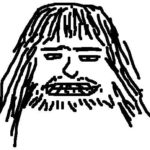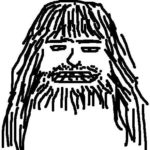In the 1564 printed edition of his cryptography manual, Giovan Battista Bellaso included seven challenge ciphers for his readers to break, along with a set of clues: these all remained unbroken and in obscurity until Augusto Buonafalce wrote about them in 1997, 1999, and 2006 in the journal Cryptologia.
But that’s all changed now!
Tony Gaffney – who Cipher Mysteries regulars should remember from his book “The Agony Column Codes & Ciphers” (under the nom-de-plume ‘Jean Palmer’), his reading of the Dorabella cipher, and his corrections to the Bellaso cipher transcriptions – has managed to crack Bellaso Challenge Cipher #6, despite the handicap of not actually being able to read Italian. 🙂
Here’s the ciphertext in question (with Tony’s starting point highlighted), followed by a description (based closely on the document he posted to the Ancient Cryptography forum) of how he used that to begin solving the entire cryptogram. (Incidentally, if this all comes across a bit like a kind of linguistic Sudoku, it’s because that’s essentially how most non-machine code-breaking is done)…
DP QBGTA ITP LBIEE DFIIHO LI AQILIFF SO NILEECHL OMGTTIE=
CZXRC CGEDFLLIILBGGP PLBBIUNO UL QURNXSRRNB OR ACFEDFLL=
ILBFI PLACFODACU AP UHEEOI PLSGGAOLRIBLNGIBLNPE SO ROCDBCG
BU PCLICB MR RBERPUGSTSLB PLACFOEXBUBLB BPSPDXG QU BDUU
DCCAGE FCFXSFP HP MBHI LH EOMGU FSDDHEIJMG FPDHQMPDD.
Having a repeated block of four letters five letters apart implied that the cipher system involves cycling through five different cipher alphabets: and so Tony trawled through Bellaso’s clues looking “for any word that had a period 5 repetition in it ie. lontano; riteovata; lequale; etc.” When he hit the very promising-looking word consequentemente, he lined that up with the ciphertext letters with the cycle numbers beneath:-
??consequentemente??
PLSGGAOLRIBLNGIBLNPE
12345123451234512345
There’s a problem here, in that in alphabet #4 ‘G’ appears to encipher both ‘o’ and ‘m’: yet because most printed ciphers suffer from typesetter errors, Tony ignored this and marched bravely onwards. 🙂
His next two steps forward were to notice (a) that the second letter in the group shown must be ‘t’ (it occurs in cycle #2 in the same word) and (b) the final letter must be ‘i’ (because ‘e’ is its reciprocal in cycle #5 – Bellaso was fond of reciprocal ciphers, i.e. ones that perform both the ciphering and the deciphering) – so, guessing that the first letter is ‘e’, the above section of ciphertext resolves to ‘et consequentement ?i‘
Observing that plaintext ‘e’ appears to get enciphered as P in #1; O in #2; N in #3; and I in #5, Tony’s next angle was to rely on the five cycling alphabets’ probably having some kind of symmetry – in particular, because P O N are all a single alphabetical step away from each other, he thought it likely that the bottom half of the alphabet was shifting along by one place in each cycle. This guess let him start to fill out the 5 cycles in more detail:-
????b?e?g??? 1
????nop?????
????b?e?g??? 2
?????nop????
????b?e?g??? 3
??????nop???
????b?e?g??? 4
???????nop??
????b?e?g??? 5
????????nop?
Where next? Well, Tony now turned his gaze on a second repeated feature in the cryptogram, which appeared to be two words formed from the same linguistic root, but with a different prefix and suffix each. Did he now have enough letters to solve this? He decided to give it a go regardless:-
ACFEDFLLILBFI &
CGEDFLLIILBGGP
??o??????????? ???o???t?????
CGEDFLLIILBGGP & ACFEDFLLILBFI
51234512345123 5123451234512
??o???t???n??? s?????tq??n??
CGEDFLLIILBGGP & ACFEDFLLILBFI
12345123451234 1234512345123
?????tq?????o? ?s????q??????
CGEDFLLIILBGGP & ACFEDFLLILBFI
23451234512345 2345123451234
so???q???t?one ???p?????t???
CGEDFLLIILBGGP & ACFEDFLLILBFI
34512345123451 3451234512345
?np??????q???? ???o?????q???
CGEDFLLIILBGGP & ACFEDFLLILBFI
45123451234512 4512345123451
Looking at the fourth set, he wondered if ‘t?one‘ might well be ‘tione‘, and so tried them both “as if they were the same word”. Removing the extra I from the first word yields:-
?np?????tione ???p?????ti??
CGEDFLLILBGGP & ACFEDFLLILBFI
4512345123451 3451234512345
His original table for #3 maps ‘e?g‘ to ‘nop‘ so it seemed entirely possible that ‘F’ might encipher ‘o’: and so guessed that this word was something along the lines of the word ‘proportion‘:-
?n proportione ??? proporti??
CG EDFLLILBGGP & ACF EDFLLILBFI
45 12345123451 345 1234512345
Working with the code-breakers’ two secret weapons (controlled mistakenness, allied with bloodyminded persistence), Tony moved forwards, safe in the knowledge that if his guesses were significantly wrong his errors would soon present themselves. How much of the five alphabets did he now have?
??r?b?efgl?? #1
??i?nopqt???
??r?b?efgl?? #2
??di?nopqt??
??r?b?efgl?? #3
????i?nopqt?
??r?b?efgl?? #4
??u??i?nopqt
??r?b?efgl?? #5
??t???i?nopq
He now moved on to the next weakest link in the ciphertext, a long group of letters (‘RBERPUGSTSLB‘) that he thought might well now be solvable with the letters he had:-
i?nu??qc???? di??e?p??ati ??iif?o?g?q? u?pdgrnalcp? ?no?l?t???on
RBERPUGSTSLB RBERPUGSTSLB RBERPUGSTSLB RBERPUGSTSLB RBERPUGSTSLB
123451234512 234512345123 345123451234 451234512345 512345123451
Pleasingly, ‘distemperati‘ seemed to fit the second version (‘di??e?p??ati’): and so he proceeded with all the remaining words in the challenge cipher.
Tony’s final plaintext (parallel with the ciphertext, and the matching cycle numbers) looks like:-
della giors cre ticip rocede qualche ilcorpo nostro ecoposto
DP QBGTA ITP LBIEE DFIIHO LI AQILIFF SO NILEECHL
23451 451 23451 234512 2345123 34512345
etorganizato inpropor tione musicabe poi maicretici sono
OMGTTIECZXRC CGEDFLLIILBGGP PLBBIUNO UL QURNXSRRNB OR
23451234-451 45123451*23451 51234512 4512345123
disproportine etdiscrdia nella musica etconsequenteoenteli nostro
ACFEDFLLILBFI PLACFODACU AP UHEEOI PLSGGAOLRIBLNGIBLNPE SO
3451234512345 1234512345 234512 12345123451234512345
uloriin quella giorni sono distemperati etdiscordanti ilferro inogni
ROCDBCG BU PCLICB MR RBERPUGSTSLB PLACFOEXBUBLB BPSPDXG QU
4512345 345123 234512345123 1234512345123 3451234
sara condoi soprese della vite per petoa saratirato serumpera
BDUU DCCAGE FCFXSFP HP MBHI LH EOMGU FSDDHEIJMG FPDHQMPDD.
2345 512345 5123451 2345 12345 5123451234 512345123
Bellaso appears (as per his book) to be using two letter groups to stand in for common words:
- DP — della
- LI — mille/qualche
- SO — no macati e sequir/quanto/ve habiamo/scritto/nostro
- UL — vostra/poi
- OR — perilche/sono
- AP — della/nella
- BU — ditto/quella
- MR — il vostro/sono
- QU — quella/inogni
- HP — della/imperoche
- LH — intutto/per
Finally, Tony notes – “I am greatly indebted to Augusto Buonafalce for his help in translating some of the words and supplying me with copies of his English translations of the books.”
The plaintext refers to Bellaso’s clue #8, and discusses the well being of the body at different times, which could well refer to the theories of the Renaissance astrologer Andrea Argoli.
All I can really say is that I think this is a splendid achievement, and I wish Tony the very best of luck with the other challenge ciphers! Excellent, well done! 🙂

